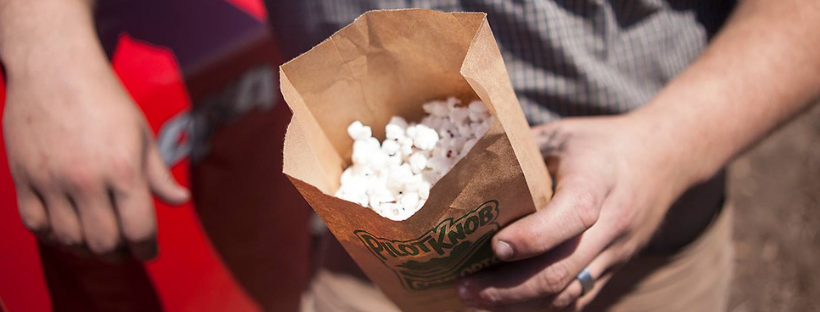 January 29, 2022 1:26 pm
January 29, 2022 1:26 pm

Each acre is about a football field in size, and each one requires planning well ahead of planting…but how special is our #awesomepopcorn?
In winter months, there are still many things to do on the farm—but admittedly none are nearly as “urgent” as when the weather is fair. Our family farm divested of livestock in the 1970s when Grandpa Ed and Dad’s health (they had TERRIBLE sinuses) and economic signals (US Secretary of Ag, Earl Butz famously said “Get big or get out.”) merited a change on Woodlawn Farms (our name at the time). Our friends that still have critters on the farm have plenty of daily chores and work. We readily acknowledge our crops-only operation is relatively “sissy” in comparison during the cold winter months…and we’re okay with that!
Still, there are financials to review, long-term plans to consider, crops to delivery to market, equipment repairs to make, and many other projects to consider—especially bringing #awesomepopcorn to market as a focal point! One of such project is our building our crop plan; what will we plant the following season.
American farmers have local, regional, national, and international markets. Depending on the crops you grow, each of the markets may be weighted differently. Our family farm resides right in the heart of corn and soybean country. Local ol’ timers muse that “the wheel fell off in a good spot,” referring to the fortune that their families ended up settling here generations ago rather than stopping too soon (where it’s too wet further east) or advancing too far (where it’s too dry further west). Pilot Knob, our popcorn’s namesake, is the name of the highpoint that overlooks where Great-Great Grandpa J.W. Bowman settled in 1877. It’s a watershed divide with the water to the north advancing to the Illinois River and the water to the south advancing to the Mississippi River. We’re a high-point well suited to corn and soybean…and now, POPCORN too!
That said, we start building our crop plan well ahead of the tractor and planter hitting the field. Perhaps we can get into commodity price analysis, futures and options, as well as macro-economics in another blog post—but suffice it to say that the world needs corn and soybean, the US needs corn and soybean, and such a large market is impacted by everything from the value of the US Dollar, interest rates, currency exchange rates, oil prices, and yes—the actual supply and demand estimates of the corn and soybean crops themselves.
We had a pretty good idea what we would do on our farm for this coming year as early as August last summer. That’s when we built preliminary profit/loss statements to see what’s the best economic decision on each acre. But that’s not enough. We’re not interested in maximizing a dollar in the short-term in exchange of long-term pain. We also balance economics with stewardship and logistics. Stewardship means we must do what is right overall, not what is convenient or simply profitable—that means, for example, rotating crops to not exhaust the soil or cause erosion with excessive tillage. If it takes 500-many thousands of years to create 1” of prime topsoil, you invest in stewardship instead of one year’s profits! Logistics includes considering our labor force spread across the critical time windows—even if corn (or POPCORN) was the most profitable crop, it isn’t possible for us to grow 100% to that crop since we need to spread out the workload.
US farmers are making the same decisions nationwide this winter. In 2012, the last US Census of Agriculture, this happened on 340 Million acres of cropland! Here’s where you, as a popcorn-lover, get to the point of this blog. Popcorn covers only 218,000 acres in the US, or 0.06%. In comparison, corn is 92.7 Million acres. It’s a dramatic “quality over quantity” exhibit isn’t it? But the quality considerations don’t stop there. To our knowledge, only a very small percentage of the popcorn grown is “hull-less” as that is a trait that improves quality, but reduces yield potential (i.e. farmers have less to sell!). The balance of that 218,000 acreage are the commodity popcorns—they yield better but don’t have the same high-natural taste and they usually do require toothpicks! This year, our farm is budgeting 40 acres of our crop plan to #awesomepopcorn, probably 25 acres to #rusticred and 15 acres to #bluebounty. We are the only ones that grow “hull-less,” #notoothpick popcorn in the heart of corn and soybean country, via strip-tillage and with micro-nutrients and reduced pesticides.
Here’s the takeway: our #familyfarm grows special popcorn. Only 40 acres in the entire US grows these hybrids in this manner in this ideal climate for your family’s comfort. 40 #awesomepopcorn acres out of 218,000 acres of almost entirely commodity popcorn out of 340 Million US cropland acres. This is pretty special stuff. So the next time you enjoy a bag, consider the tender, loving, special care that went into those beautiful red and blue kernels before they arrived in your kitchen. We hope such a thought gives one more reason for you to #makememoriespop.
Poppingly Yours,
Andrew
